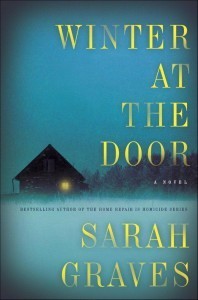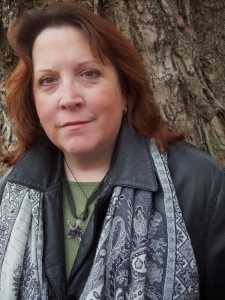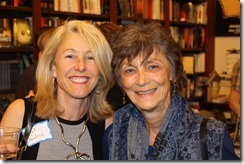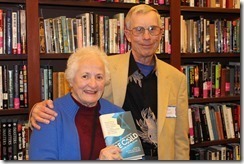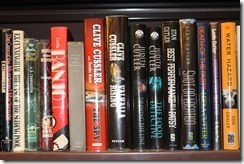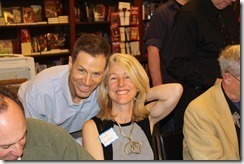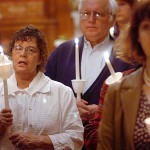Lea Wait's Blog, page 322
May 6, 2014
Hello Again from Eastport, Maine

The author at home.
Hello again from Sarah Graves, writing to you once more from Eastport, Maine. It’s been a long, cold, dark winter here, and quiet as an abandoned house, but now we are waking up: to mud when it’s raining, which it has been a lot, and to dust from the street sweepers the rest of the time. But at least it’s not snowing, or it wasn’t the last time I looked (knock wood).
One thing long winters are good for is writing books, since escaping into another world looks better and better the darker and colder it gets outside. I’ve started a new series, this time set in Aroostook County and starring Lizzie Snow, a Boston ex-homicide detective on the track of her missing niece. Once she gets out in the boondocks, though, she finds there’s plenty of local mayhem for a murder cop to investigate, and that the mean streets of Boston have nothing on the North Woods for general deadliness — and one person’s murderous plans in particular.
Meanwhile the rest of Eastport is coming back to life, too, and some parts of it are being reborn.. I’ve been particularly happy with Shead High School’s radio station, WSHD 91.7, because it’s begun playing lots of jazz and indie pop. The former is among my favorite musical genres, and I’m always glad for the chance to hear new sounds. Now my background music resembles the sound track for a smart indie film and who doesn’t like that?
And another source of happiness recently is the cover of WINTER, a big change from the kinds of covers I’ve had in the past and one I’m liking a lot. I mean don’t get me wrong but this looks so…ominous! And since my goal in life is to raise your anxiety level, that’s good.
Also: Congratulations to Barb and Julia for their Agatha noms and to Kathy for her GOH-ness and Dorothy for her lifetime achievement award at this year’s Malice Domestic, and Vicki for her story’s inclusion in the MWA collection. The Maine contingent seems to be pulling down honors right and left, lately, which doesn’t surprise me a bit. Nice to see the rest of the world noticing what we already knew: there’s great bunch of writers in this state and on this blog, of everything from short stories to novels.
 In past years, I’ve been finishing up my winter’s writing by May or so and am ready to go out into the garden to dig in the dirt. But this year, my deadline for the second book in the Lizzie Snow series isn’t until September so although I do see the end in sight, so far the spring flowers to the right have had to be enough for me. They’re in a lovely panel of stained glass in one of the shop windows downtown, where everyone’s getting ready for — yes! — tourists. Love ‘em or not, they are on their way; I personally enjoy the hustle and bustle of visitors, especially at the beginning of the season.
In past years, I’ve been finishing up my winter’s writing by May or so and am ready to go out into the garden to dig in the dirt. But this year, my deadline for the second book in the Lizzie Snow series isn’t until September so although I do see the end in sight, so far the spring flowers to the right have had to be enough for me. They’re in a lovely panel of stained glass in one of the shop windows downtown, where everyone’s getting ready for — yes! — tourists. Love ‘em or not, they are on their way; I personally enjoy the hustle and bustle of visitors, especially at the beginning of the season.
 Antiques, t-shirts, baked goods, art and crafts, mugs, candy, souvenirs, hot dogs, ice cream…pretty much the whole shebang is cooked up, spiffed up, and put on display for our guests to delight in, and we all enjoy it, too. At left is the newly done window of the Eastport Art Gallery, where the first show of the season is Works On Paper. Sadly, the Pickled Herring is no more but we do have the Liberty Café, where great Greek food and a cozy bar with a big screen TV for sports has been drawing raves.
Antiques, t-shirts, baked goods, art and crafts, mugs, candy, souvenirs, hot dogs, ice cream…pretty much the whole shebang is cooked up, spiffed up, and put on display for our guests to delight in, and we all enjoy it, too. At left is the newly done window of the Eastport Art Gallery, where the first show of the season is Works On Paper. Sadly, the Pickled Herring is no more but we do have the Liberty Café, where great Greek food and a cozy bar with a big screen TV for sports has been drawing raves.

But nothing can really beat the show Eastport itself puts on: here’s the tugboat resting at the fish pier after guiding in another container ship. Things will be lively around here from Memorial Day until the beginning of next winter, which you’ll excuse me if I really can’t bear to think about that so soon after this recent one.
And that’s it for now from Eastport, Maine, where with any luck at all next time I write to you it will be about the garden shovel and not the (shudder) snow shovel.
Boiled Over Released in Print, eBook and Audio!
Hi. Barb here, celebrating the fact that my blogging day is my actual release day!
Boiled Over the second book in the Maine Clambake Mystery series was released today from Kensington Publishing in mass market paperback and ebook form.
For Julia Snowden, the Founder’s Day summer celebration in Busman’s Harbor, Maine, means helping her family’s clambake company to prepare an authentic taste of New England seafood. Any Mainer will tell you that a real clambake needs wood for the fire . . . so why is there a foot sticking out of the oven?
The townspeople want to pin the murder of the RV park owner on Cabe Stone, a new employee of the Snowden Family Clambake Company–who bolted from the crime scene and disappeared.
Julia knows having another murder associated with her family’s business is a recipe for disaster . . . but who is the killer? Cooking up a proper investigation doesn’t leave much time for the rest of Julia’s life, and this is one killer who’ll do anything to stop her from digging up clues . . .
 Even more exciting to me, Audible is simultaneously releasing the audiobook. I’m so happy to have an audiobook, my first ever, because I know so many people who enjoy them. But I’m not sure if I’ll listen to it. I’m not worried the narrator won’t be good. I’ve heard good things about her and she is very conscientious–emailing me with questions about pronunciation. And I’m not afraid her narration will be different than the voice I hear in my head as I write. I’m just not sure I want to hear my own words coming back at me.
Even more exciting to me, Audible is simultaneously releasing the audiobook. I’m so happy to have an audiobook, my first ever, because I know so many people who enjoy them. But I’m not sure if I’ll listen to it. I’m not worried the narrator won’t be good. I’ve heard good things about her and she is very conscientious–emailing me with questions about pronunciation. And I’m not afraid her narration will be different than the voice I hear in my head as I write. I’m just not sure I want to hear my own words coming back at me.
But for those of you who love audiobooks (and everyone else), I urge you to buy it. It’s a fast-moving tale I really enjoyed writing.
May 4, 2014
A Visit from Beth Oliver, Ghost Hunter
Kaitlyn/Kathy: I first met Beth Oliver a long time ago in a galaxy far far away . . . in other words, back when we were both members of the fledgling Maine Romance Writers of American chapter (MERWA). During the years since, in addition to writing Gothic paranormal mystery novels (Obsidian, Three Truths, and Stealing Darkness), Beth worked as a paranormal investigator for Maine Ghost Hunters. With that background, how could we not ask her to visit us here at Maine Crime Writers to talk about her experiences?Take it away, Beth.
The things that scare most people don’t scare me. I’m not talking about roller coasters, bungee jumping, or being confined to small spaces. Instead, I am referring to the search for the existence of spirits.
For most, the idea of sitting in the semi-darkness while calling out to some nameless entity would be reason enough to question their sanity. But since I’m not about to bungee jump, ride a roller coaster or confine myself to a small space, this is the risk I was willing to take.
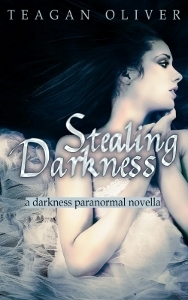 Have I ever been scared while investigating? I’d be crazy if I said no. I’ve had disembodied energy spin objects in my hand. I’ve been propelled up a staircase by a guiding unseen hand and I’ve seen blue balls of energy dance in the night. Have I seen a ghost? The jury is still out on that, but I do know that what I’ve seen is enough to convince me that our souls continue long after our demise.
Have I ever been scared while investigating? I’d be crazy if I said no. I’ve had disembodied energy spin objects in my hand. I’ve been propelled up a staircase by a guiding unseen hand and I’ve seen blue balls of energy dance in the night. Have I seen a ghost? The jury is still out on that, but I do know that what I’ve seen is enough to convince me that our souls continue long after our demise.
The television shows only have it partly correct. In the interest of keeping an audience and a short time frame they tend to leave out some of the less glamorous aspects of ghost hunting. They gloss over the basements filled with humongous spiders, the long hours of waiting for anything to happen and lots of nights with limited sleep.
Often, being called to investigate means travelling long distances and finding yourself in stranger’s houses as you struggle to put aside any preconceived ideas and beliefs to search for something that may never even show itself.
 There are many reasons for people to seek out a ghost hunter, but the most prevalent ones that I’ve heard are fear and grief. There are the occasional thrill seekers, but most are only looking for answers. Answers that don’t always reveal themselves. The most I can do is offer assistance and guidance. Anything else has to come from the client or the spirit.
There are many reasons for people to seek out a ghost hunter, but the most prevalent ones that I’ve heard are fear and grief. There are the occasional thrill seekers, but most are only looking for answers. Answers that don’t always reveal themselves. The most I can do is offer assistance and guidance. Anything else has to come from the client or the spirit.
Ultimately, fear can be the catalyst that holds you back or propels you forward. It can be the thing that makes you stronger than you ever thought and open your mind to possibilities beyond your comprehension. The same energy that manifests from our fears is the energy that makes me believe that it is strong enough to continue after our death.
 Beth Oliver writes Gothic Paranormal Mysteries under the name Teagan Oliver. Her latest, Stealing Darkness is available through Amazon Kindle as an ebook. You can find out more about her paranormal adventures at www.TeaganOliver.com and through her GhostGirl blog at Gotghost.blogspot.com.
Beth Oliver writes Gothic Paranormal Mysteries under the name Teagan Oliver. Her latest, Stealing Darkness is available through Amazon Kindle as an ebook. You can find out more about her paranormal adventures at www.TeaganOliver.com and through her GhostGirl blog at Gotghost.blogspot.com.
May 2, 2014
Weekend Update: May 3-4, 2014
 Next week at Maine Crime Writers there will be posts by Barb Ross (Tuesday), Sarah Graves (Wednesday), John Clark (Thursday), and Dorothy Cannell (Friday), with a special guest blog on Monday from Beth Oliver (aka Teagan Oliver), a Maine writer who is also a ghost hunter. Next weekend, we’ll post a special Weekend Update Report on this weekend’s Malice Domestic.
Next week at Maine Crime Writers there will be posts by Barb Ross (Tuesday), Sarah Graves (Wednesday), John Clark (Thursday), and Dorothy Cannell (Friday), with a special guest blog on Monday from Beth Oliver (aka Teagan Oliver), a Maine writer who is also a ghost hunter. Next weekend, we’ll post a special Weekend Update Report on this weekend’s Malice Domestic.
In the news department, here’s what’s happening with some of us who blog regularly at Maine Crime Writers:
Dorothy Cannell, Kathy Lynn Emerson/Kaitlyn Dunnett, Kate Flora, Barbara Ross, and Lea Wait (and MCW alum, Julia Spencer-Fleming) are at Malice Domestic in Bethesda, Maryland this weekend. Dorothy is one of the three Lifetime Achievement Honorees (along with Joan Hess and Margaret Maron). Kathy/Kaitlyn is Guest of Honor and will be interviewed by Kate Flora on Saturday afternoon. Barb is up for two (count ‘em, two!) Agatha awards, one for her short story “Bread Baby” and one for best contemporary novel for Clammed Up. Julia’s Through the Evil Days is also a finalist for best contemporary novel. Lea wrote Kathy’s profile in the Malice program book and will be doing a presentation in “Authors Alley” on Sunday, talking about her new Haven Harbor Needlepoint series. The Malice website, with more details, is at http://www.malicedomestic.org.
From Kathy/Kaitlyn: Just a side note: it was my post here on cussing in cozies that inspired the panel I’m participating in on Sunday morning at Malice. Nora McFarland will be moderating “Authors Who Tackle Difficult Subject Matter” and my fellow panelists are Jeff Cohen, Con Lehane, and Tracy Weber. It should be a lively discussion!
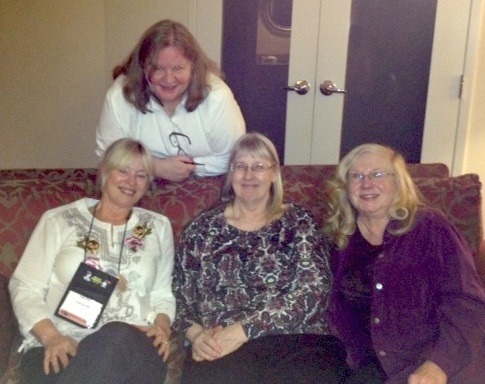
Kate, Barb, Kathy/Kaitlin and Lea in Kathy’s Guest of Honor suite at Malice Domestic.
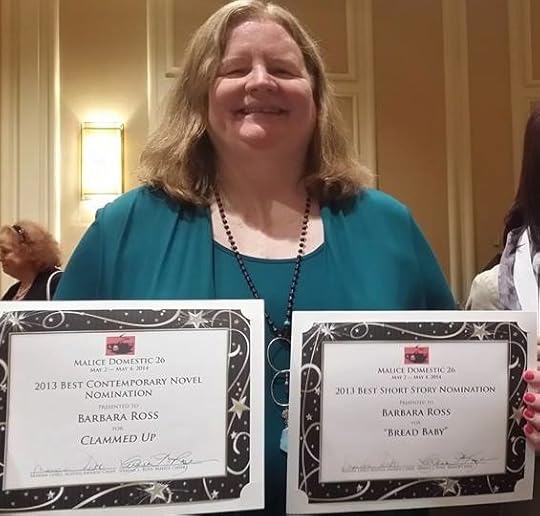
Barb’s two (count’em) Agatha nominations at Malice Domestic.
John Clark Here: Enjoying the satisfaction of getting both the juvenile and YA Edgar winners right again. This makes two out of three times I’ve done this since starting to predict them here at MCW.
An invitation to readers of this blog: Do you have news relating to Maine, Crime, or Writing? We’d love to hear from you. Just comment below to share.
And a reminder: If your library, school, or organization is looking for a speaker, we are often available to talk about the writing process, research, where we get our ideas, and other mysteries of the business. Contact Kate Flora: kateflora@gmail.com
April 30, 2014
Why Mystery Conferences?
Lea Wait here — and in Bethesda, Maryland, where today is the day most attendees will arrive at the Hyatt Regency for Malice Domestic, the annual mystery conference featuring “cozy,” or “traditional” mysteries. This year more than 150 authors will be there .. along with between 500-600 fans.
Recently I also attended a one-day mystery conference (Maine Crime Wave) in Portland, Maine. It was small, as mystery conferences go — about 80 people were there — and everyone I spoke with was an aspiring or published author of mysteries.
Two very different sorts of conferences. (I won’t even start to list the number of mystery conferences held every year, ranging from the granddaddy of them all, Bouchercon, which attracts writers of all mystery genres and several thousand fans .. down to that “first annual” Maine Crime Wave.) I’m often asked, by fans and writers … “Why? Why attend a mystery conference?
To begin with some conferences, like the one in Portland, and Sleuthfest (in Florida) are aimed at writers. Workshops and talks are about writing techniques; marketing; the state of the industry; and often agents and editors are in attendance. Other conferences, like Bouchercon and Malice and Left Coast Crime, are aimed more at readers: panels feature published writers talking on topics such as “The weirdest thing I’ve done in the name of research”; “Why are so many crime novels set in New England?”; “What happens when weather interferes with solving a crime?” And so forth. Most of them are fun topics, and give the authors on the panels a chance to plug their books. Some conferences, like Crime Bake (in Massachusetts in November) try to appeal to both readers and writers.
I attended my first mystery conference as a “pre-published” author. I was looking for an agent. (I didn’t find one there.) The conference was a two-day one in Philadelphia, and I attended one day. I learned a lot, and loved the idea of a whole room full of people (all of whom knew a lot more about mysteries than I did) discussing serial killer fiction and cozies and who the up-and-coming authors were. I went home exhausted, but intrigued. I had my first inkling of how much I had to learn.
My next conference was Malice Domestic several years later, and I attended it with excitement as a first-time Agatha Award nominee. (Did I mention some conferences give out coveted awards?) Yes, I was overwhelmed .. but I was a part of everything. I didn’t exactly feel at home, but I did feel part of the action.
Since then I’ve attended mystery conferences all over the United States… an average of 2-3 each year, which is a small number. I know authors who attend 10-12 regularly.
But attending a conference takes time away from writing …takes money … and the number of books sold at each conference doesn’t justify the trip. What does justify it is meeting fans, connecting with booksellers, hobnobbing with other authors (and agents and editors,) and getting out into the world and away from your computer screen.
If you’re thinking of signing up for a mystery conference, here are some basic hints:
1) Decide if you’re interested in a fan conference or a conference on writing. They’re not the same.
2) If you’re published, register early and try to get on a panel so you and your book(s) can be showcased. This will also mean your books will be carried in the conference book room.
3) If you have (and authors should have) bookmarks, postcards, pins, brochures … anything that markets your books, bring multi-copies. There are usually tables on which authors can put these giveaways. And attendees do load up!
4) Even if you’re on a panel, double-check with one or more of the bookstores that will be at the conference to make sure they’ll order and bring copies of your latest book.
5) Attend as many panels/talks/events at the conference as you can .. but if you’re exhausted, sitting at the bar (even if you drink coffee) is not a bad idea. Friendships and book deals are made at conference bars.
6) Don’t be shy. Introduce yourself to people sitting or standing next to you. After all, you already have mysteries in common. And if your favorite author is there … tell him or her how much you love their books! (Authors don’t get tired of hearing that.)
7) If you’re a fan, look at the conference website for the list of attending authors, and bring copies of their books you already own to be signed. It’s better to buy the books on site .. but few authors will object to signing a book bought elsewhere.
8) Wear comfortable shoes! You’ll be walking and standing a lot and (except for some awards’ dinners) mystery conferences are casual.
9) Don’t worry about acquiring too many books. (Is there such a thing?) Most conferences have contracted with a shipper so you can have your new signed books (or dirty laundry) shipped home for you.
10) Be sure to take a notebook .. you’re going to hear about new authors, new books .. or maybe a great new plot twist for the book you’re writing. You don’t want to forget anything. And you’ll be exhausted at the end of two or three days. Take my words for it.
So … as you’re reading this I’m on my way to Malice Domestic. Many of us Maine Crime Writers will be there. It’s an especially great year for Maine … Kathy Lynn Emerson is the guest of honor at Malice. Dorothy Cannell (along with Margaret Maron and Joan Hess) is receiving a Lifetime Achievement award. Barbara Ross is nominated for — not one — but TWO Agathas. (Best novel and best short story.)
I’ll be a part of the “Author Go Round” Friday morning, talking about my latest books, and I’ll be doing an “author’s alley” … a short presentation … at 10:00 Saturday morning, talking about my new mystery series that will begin in January of 2015. And, most of all, I’ll be cheering on my fellow Mainers, and having a great time.
Wish you were here!
ICE COLD Launch Party–New York City!
Yesterday was the launch party for Mystery Writers of America’s newest short story anthology ICE COLD: Tales of Intrigue and Suspense from the Cold War. It was held in Manhattan at Mysterious Bookshop, and Ed and I drove down from Maine to attend.
I am so happy and grateful to have had my short tale “A Neighbor’s Story” chosen for this fine anthology! Here are some photos from this fun event:
Thanks to my husband, Ed, for his pics of the gala launch party yesterday at Mysterious Bookshop in New York! Further descriptions to follow….
But for now I am enjoying being in NYC! (although it is JUST as chilly as Maine…)
April 29, 2014
Why Crime Writing Isn’t As Easy As You Think – Because Stuff Happens
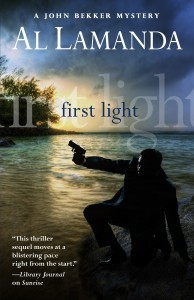 Al Lamanda: Writing a mystery is not as easy as you might think when fall decides to fast-forward to winter and you have to put your latest chapter on hold to shovel the new foot of snow off the roof, and deck, and driveway. And then repeat this process every other day until spring. Oh, I know I live in a cold weather state where I’m supposed to love to play in the snow, slide down a mountain on sticks and hike through the woods wearing tennis racquets on my feet, but I have deadlines to meet here and snow is nothing but one big distraction for me.
Al Lamanda: Writing a mystery is not as easy as you might think when fall decides to fast-forward to winter and you have to put your latest chapter on hold to shovel the new foot of snow off the roof, and deck, and driveway. And then repeat this process every other day until spring. Oh, I know I live in a cold weather state where I’m supposed to love to play in the snow, slide down a mountain on sticks and hike through the woods wearing tennis racquets on my feet, but I have deadlines to meet here and snow is nothing but one big distraction for me.
And the holidays are always good for lost weeks at the keyboard. Especially when you have to drive hundreds and hundreds of miles to eat an enormous meal (at a time of day when you’d usually have no more than two pieces of toast) with a large group of relatives that I have divided into three categories. The first category consists of the “I have a great story to tell you that your next book should be about” and, of course it’s the same long-winded story as last year, and the year before that. (For the record, I don’t think a story about elderly people with ailments such as arthritis and eczema, using their various ailments like a super power to solve a murder is on my horizon anytime soon.) Category two is the critics. The, “I hated the end and I would have written it differently crowd. They bring notes on what my next novel should be about according to what they think I should write about. The third category is the “Where’s my free books bunch?” I wonder if I showed up at your office would you give me free dental work, or a free life insurance policy, or free electrical work simply because we are somehow related?
Additional winter fun that slowed the progress on my latest project was ice. Not the friendly little cubes 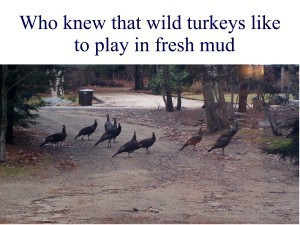 of the stuff you find floating in a glass of bourbon, but the sheet of the stuff that grows on your three-hundred-foot-long, uphill driveway after the three day spell known as the January thaw. And you desperately need to get to the library, but you’re not going anywhere because you drive a car and not an M1 Abrams tank. So you call this guy you know who delivers sand (who knew people did this for a living back home in New York?) all winter and by the time he arrives and you help him spread the sand, the library is closed. And, for the next three days, so is your research.
of the stuff you find floating in a glass of bourbon, but the sheet of the stuff that grows on your three-hundred-foot-long, uphill driveway after the three day spell known as the January thaw. And you desperately need to get to the library, but you’re not going anywhere because you drive a car and not an M1 Abrams tank. So you call this guy you know who delivers sand (who knew people did this for a living back home in New York?) all winter and by the time he arrives and you help him spread the sand, the library is closed. And, for the next three days, so is your research.
And the evil cup of coffee. Because, in the middle of a chapter that you forgot to save because your mug was empty and you just had to have more, you go to the kitchen, and, (did I forget to mention the raging February snowstorm that was happening at the time) power goes out and the entire chapter you worked on for hours and hours is gone as in it ain’t coming back anytime soon.
 Another delay came at the hands of having all four seasons in one week, a particular favorite of mine. Where on Sunday it’s a lovely fall day and you’re staring out the window instead of writing and longing for summer. And the very next day is summer and temperatures sore to eighty-one degrees and you open every window and door and for one afternoon you pound the keys like a madman. And you go to bed feeling like you’ve accomplished something and wake up the next day to four inches of snow on the ground and thirty-two degrees, and you spend half the morning trying to remember where you put the snow shovel. And the day after that, which is a lovely spring day and the snow melts quickly and you have a yard and driveway full of mud and you need chest waders to get the mail.
Another delay came at the hands of having all four seasons in one week, a particular favorite of mine. Where on Sunday it’s a lovely fall day and you’re staring out the window instead of writing and longing for summer. And the very next day is summer and temperatures sore to eighty-one degrees and you open every window and door and for one afternoon you pound the keys like a madman. And you go to bed feeling like you’ve accomplished something and wake up the next day to four inches of snow on the ground and thirty-two degrees, and you spend half the morning trying to remember where you put the snow shovel. And the day after that, which is a lovely spring day and the snow melts quickly and you have a yard and driveway full of mud and you need chest waders to get the mail.
With forty or so pages left to write in my latest mystery, it was looking good that I would meet the required deadline. Until I happened to mention that the old sofa wasn’t as comfortable as it once was, which led to a week-long hunt for a new one that dwarfed the old one and cramped the room, so out with the old entertainment center and in with the new, sleeker one, which meant, of course, shopping for a new, sleeker television, which, when all was said and done made the windows appear old and worn, so hello window guy, can I waste three days picking out windows with you, and while we’re at it, let’s throw in new doors just because.
So winter is done, and so is my latest mystery novel, and I will write another because it makes the stuff that happens so much more interesting.
April 27, 2014
People behind the curtain in the Maine Library Community

Hartland Public Library
One of the best aspects of the Maine Library community is the willingness of people who have unique skills to step up and push the library world forward. I’ve had the distinct pleasure of knowing and working with several of them. Tom Abbott, Dean of Library Services at the University of Maine at Augusta, along with the Late Walter Taranko, were responsible for bringing the University of South Carolina’s Masters in Library Services degree program to Maine in 1995, changing forever the landscape by creating an opportunity for hundreds of Maine citizens to get a degree that before that time was only available out of state. Walter was also the man who introduced me to the amazing world of resource sharing, something I’ve raised to an art form.

Abbott Memorial in Dexter
Karl Beiser did more to drop kick the library systems in Maine into the world of technology than any three other people. If you’ve used an online catalog or borrowed something through MaineCat, thank Karl. He was responsible for most of what’s under the hood that makes finding, lending and borrowing items such a seamless process for Maine residents.
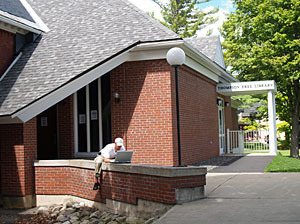
Thompson Library in Dover-Foxcroft
When three of us in central Maine wrote a grant to create an open source library system to serve libraries in Penobscot, Piscataquis and Somerset Counties, we floundered because all of us were too blasted busy running our libraries to be able to figure out how to get the consortium off the ground. Enter Chris Maas, retired law firm consultant. He stepped in and has invested an incredible amount of time finding a support guy, negotiating with various hosting services and figuring out why certain things refuse to play nice. It’s fair to say, the Maine Balsam Libraries Consortium would still be floundering if it wasn’t for his willingness to step in and help. I asked Chris to write up something about himself and how he got involved. We had intended it for National Library Week, but were unable to do so, hence it appearing today. So, without further ado, meet Chris Maas.
Chris and his wife at an Easter celebration in Bangor
I owned a technology consulting group in Washington D.C. until I retired and moved to Dover-Foxcroft with my wife in 2007. I loved the work and working with law firms all over the world. While demanding, law firms proved to be very value oriented. Once they understood the value of technology in their firms, they were generally willing to pay the price (both time and effort) to implement it properly. Over the years, I grew to have a great deal of respect for the industry and the role that that profession plays in a civil society. (I used to say “if you want to see what life would be like without lawyers, move to Russia”).
As much as we appreciated living in big cities all of our lives, when it came time to retire, we looked for an old house in a quiet place with no traffic. Since, of all the places we had lived, we had never lived in New England, we thought that mid-Maine would serve us well – and it has. Both my wife Karen and I have always been readers, our new town had to have a good library. We found that in Dover-Foxcroft – not just the collections, but the programs and the excellent staff. Within a year the librarian, Helen Fogler, knowing of my technology background asked for help in implementing a new web based computer system under the terms of a grant that a group of libraries in mid-Maine had recently received. I joined forces with John Clark (who filled in my gaps in knowledge of libraries and technology). We settled on an open-source product which has, to date, served our needs well. In about eighteen months, we were able to get the system up and running and the first library in full circulation. Now, three years later, we have about 20 libraries (with a total of about 30 branches) up and running. Almost all of this work was done with volunteer labor. It’s been an absolute joy working with the public, school and academic librarians in this consortium (Even though never once in my prior career did I tell a lawyer joke, I do often say that my reward for having worked with lawyers for forty years, is that in my retirement I get to work with librarians!).
Living in a small New England town is democracy at its core – both the good, the irritating and the amusing. In Washington, I used to attend hearings and congressional sessions where they discussed pressing issues of national importance. While interesting and informative, I never felt that I could make much of a difference. In our new home, I found pleasure in attending the regular meetings of the town’s select board. The issues were certainly different, but the process as much more collegial – and I found that my voice was heard and I could make a difference. I particularly remember the session where the most important issue on the town’s agenda was revisions to the town’s chicken ordinance (only 6 hens permitted in the village – and no roosters). Lots of discussion about whether the ordinance should be extended to ducks, geese and other avian creatures. Who wouldn’t want to live in a town where this is the biggest problem?
My wife, worried about me hanging about the house all day, advised me to “do something useful”. There is no end of opportunities to do useful things in a community such as this. I’ve worked with the local historical society, the school board, the zoning and planning board, the town’s budget committee, several non-profit organizations and on a special project to save the old “Central Hall”. Tons to do, and you can make a difference. (“I woke up this morning with nothing to do, and went to bed without half of it getting done!).
But there is always time to read. I doubt that my wife and I, in fifty years of marriage, have failed to spend at least an hour each day reading. She has her authors and I have mine. Over the years, our “favorites” have changed often. In my case, I find myself returning often to George Orwell and to H.L. Mencken. In Orwell’s case, I find a clarity and steadfastness in seeking truth in a complex world. The opening chapters of “The Road to Wiggan Pier” is probably the most honest depiction of real labor (down in a coal mine) that was ever penned. Everyone who enters politics – at any level – should be forced to read “Politics and the English Language”. In fact, I think the Republic would be better served if they dispensed with the daily prayer that opens congressional sessions and replaced it with random members of congress reading selections from “Politics and the English Language”. We may not be better governed, but at least we would have a better understanding of how we are governed.
H.L. Mencken opens different doors for me. He was a newspaper editor and literary critic who was often out of step with the fashions of the time – both in politics, culture and literary affairs. Mencken wrote in the period after the First World War at a time of great disillusionment. As he said, people fought for a new day – and all they came home to was A. Mitchell Palmer, Harding, Coolidge and Prohibition. We seem to be living, once again, through such times. It is instructive to know that we have survived these times before and we probably will again.
Mencken was an early champion of authors such as Dreiser and Edith Wharton. In reading his essays, I’ve come across other long forgotten, authors such as Joseph Hergesheimer and Arnold Bennett. In some cases, these guys are justly forgotten from a literary standpoint, but any student of the late 19th and early 20th century would find that they add color and detail to that period that one would never get out of the history books. I once had an influential history teacher who said “If you REALLY want to know an era in history, you must read its literature”. I am thankful for Mencken for providing the links to these authors. (And thanks to Helen’s library, many of these books are still on her shelves – in the basement to be sure, but they are still there!).
I couldn’t ask for a better retirement. And working with all of my librarian friends has been the highlight of my second life.
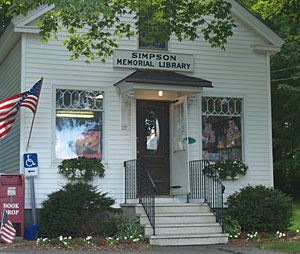
Simpson Library in Carmel
April 26, 2014
Weekend Update: April 26-27, 2014
 Next week at Maine Crime Writers there will be posts by John Clark, filling in for Gerry Boyle (Monday), Al Lamanda (Tuesday), Vicki Doudera (Wednesday), Lea Wait (Thursday), and Jim Hayman (Friday).
Next week at Maine Crime Writers there will be posts by John Clark, filling in for Gerry Boyle (Monday), Al Lamanda (Tuesday), Vicki Doudera (Wednesday), Lea Wait (Thursday), and Jim Hayman (Friday).
In the news department, here’s what’s happening with some of us who blog regularly at Maine Crime Writers:
Late in the week, Dorothy, Kathy/Kaitlyn, Kate, Barb, and Lea will be setting off for Malice Domestic, held on May 2-4 in Bethesda, Maryland. Dorothy is one of the Lifetime Achievement Honorees. Kathy is Guest of Honor. She’ll be interviewed by Kate on Saturday afternoon. Lea wrote Kathy’s profile in the program and will be doing an Authors Alley presentation on Sunday. And Barb is up for two (count ‘em, two!) Agatha awards, one of them in the same category as Maine Crime Writers alum Julia Spencer-Fleming. You can see what’s in store for all of them at http://www.malicedomestic.org and we promise pictures and stories in a future post.
Barb: Here’s the Kensington ad for the Malice Domestic program. Isn’t it great to see Kathy/Kaitlyn at the top?
An invitation to readers of this blog: Do you have news relating to Maine, Crime, or Writing? We’d love to hear from you. Just comment below to share.
And a reminder: If your library, school, or organization is looking for a speaker, we are often available to talk about the writing process, research, where we get our ideas, and other mysteries of the business. Contact Kate Flora: kateflora@gmail.com
April 24, 2014
Growing New Ideas
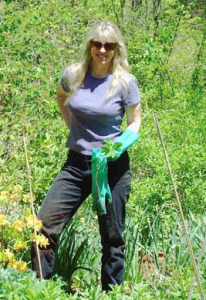 Kate Flora here, bookending the week with another post. Lately, life has felt like I’m impelled forward by some unseen hand that is shoving and nudging me along from one task to another. My to-do list seems endless. I would like to be in the garden, bending down to peek at what is coming up. Staring at the soil wet from yesterday’s rain and wondering if last year’s favorite perennials will come back or I’ll have empty places to fill in the border. Instead, I’m composing e-mails to bookstores, asking for a place in their fall schedules.
Kate Flora here, bookending the week with another post. Lately, life has felt like I’m impelled forward by some unseen hand that is shoving and nudging me along from one task to another. My to-do list seems endless. I would like to be in the garden, bending down to peek at what is coming up. Staring at the soil wet from yesterday’s rain and wondering if last year’s favorite perennials will come back or I’ll have empty places to fill in the border. Instead, I’m composing e-mails to bookstores, asking for a place in their fall schedules.
I’m organizing interviews, from the utterly frivolous ones that begin with the question: What is the title of your autobiography? And my answer: “Chicken Farmer’s Daughter” to the very detailed and serious ones that explore my journey from the fictional amateur detective in my Thea Kozak series to the very real details of the crime in Death Dealer, my September true crime from New Horizon Press Books and my parallel journey from writing what we call “strong, amateur female P.I.” to writing gritty police procedurals like my October book And Grant You Peace.
I’m organizing my lecture notes on writing dialogue from my Tuesday class at Grub Street (GrubStreet.org) in Boston titled: I’ve Always Wanted to Write, But … and planning what their next exercise will be.
I’m tweaking my notes on plotting a mystery novel for a class called Crime Fiction 101 and discussing the final programming details for this fall’s New England Crime Bake (crimebake.org) with the rest of my committee. There are edits for the short story, “Girl’s Night Out,” which is being published next month by Shebooks. More edits for the e-book and POD versions of my first three Joe Burgess mysteries. I have a note that says compile financial information. Another that is the outline of an emergency management plan for a fiction school that Thea is consulting with. The treadmill beckons. My desk is buried in filing that needs attention. There’s a small wedding picnic to plan. Phone calls to return.
Okay. You get the picture. A writer’s life is just like any other. We’re not just sitting around waiting for  the fluttery little muse to land and whisper in our ears. We have all the stuff of life to manage while holding off the urge to be creative, dive into our imaginations, and finish the next darned book.
the fluttery little muse to land and whisper in our ears. We have all the stuff of life to manage while holding off the urge to be creative, dive into our imaginations, and finish the next darned book.
In a little while, I’ll cross two more things off the list and let myself go outside. Going out into the garden isn’t really an escape from writing. Sometimes I think it is an immersion into writing. Maybe in part because my mother was a garden writer. A woman who wrote about country living and the changes in the seasons, a close observer of nature and weather and wildlife. When I’m in the garden I become a better observer. I practice the exercise I recently gave my students. Isolate the senses and use them once at a time. Sight brings the shapes of the leaves. The many colors of emerging green. The way that buds arrange themselves on the branches of shrubs. Sounds lets me hear how the wind moves through the trees. A roar. A whistle as it streaks around the corner of the house. The creak and crack as broken branches shift.
Around me, robins are rustling under the shrubs. An insistent cardinal is not so much singing as bellowing. In the distance, doves are cooing and an owl is hooting “who cooks for you?” A squirrel scolds from a high branch, while two more chase each other through the dried leaves. A runner pants past, shoes slapping the asphalt. A cyclist goes whooshing down the hill. A piece of metal rattles. Old leaves rustle. A Prius sneaks almost silently by.
Mentally, I rearrange the position of my shrubs for better symmetry and order, much as I sometimes have to rearrange scenes in a chapter to get the flow of action and reaction right. I study the tiny green spears poking up through the mulch and see that, just like the beginnings of a novel, they will fill out and grow until there’s a mature plant or a finished story. I see the beginnings of an attack by insects or predation by bunnies or the woodchuck and am instantly put in touch with the kind of anger that leads to murder. As is the case with many villains in books, any act of destruction that will bring an end to my plant’s tormentors seems entirely justified.
Then, refreshed by the air, and new ideas, my senses tuned up, I will go back to my desk, shove “to do” aside, and write today’s thousand words. And by midsummer, the garden will be lush and full and humming with bees, and the first draft of the next Thea Kozak mystery, Death Warmed Over, will be finished.
Lea Wait's Blog
- Lea Wait's profile
- 509 followers


